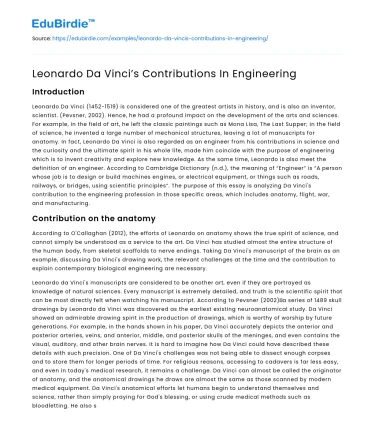Introduction
Leonardo Da Vinci (1452-1519) is considered one of the greatest artists in history, and is also an inventor, scientist. (Pevsner, 2002). Hence, he had a profound impact on the development of the arts and sciences. For example, in the field of art, he left the classic paintings such as Mona Lisa, The Last Supper; in the field of science, he invented a large number of mechanical structures, leaving a lot of manuscripts for anatomy. In fact, Leonardo Da Vinci is also regarded as an engineer from his contributions in science and the curiosity and the ultimate spirit in his whole life, made him coincide with the purpose of engineering which is to invent creativity and explore new knowledge. As the same time, Leonardo is also meet the definition of an engineer. According to Cambridge Dictionary (n.d.), the meaning of “Engineer” is “A person whose job is to design or build machines engines, or electrical equipment, or things such as roads, railways, or bridges, using scientific principles”. The purpose of this essay is analyzing Da Vinci's contribution to the engineering profession in those specific areas, which includes anatomy, flight, war, and manufacturing.
Contribution on the anatomy
According to O'Callaghan (2012), the efforts of Leonardo on anatomy shows the true spirit of science, and cannot simply be understood as a service to the art. Da Vinci has studied almost the entire structure of the human body, from skeletal scaffolds to nerve endings. Taking Da Vinci's manuscript of the brain as an example, discussing Da Vinci's drawing work, the relevant challenges at the time and the contribution to explain contemporary biological engineering are necessary.
Save your time!
We can take care of your essay
- Proper editing and formatting
- Free revision, title page, and bibliography
- Flexible prices and money-back guarantee
Leonardo da Vinci's manuscripts are considered to be another art, even if they are portrayed as knowledge of natural sciences. Every manuscript is extremely detailed, and truth is the scientific spirit that can be most directly felt when watching his manuscript. According to Pevsner (2002),a series of 1489 skull drawings by Leonardo da Vinci was discovered as the earliest existing neuroanatomical study. Da Vinci showed an admirable drawing spirit in the production of drawings, which is worthy of worship by future generations. For example, in the hands shown in his paper, Da Vinci accurately depicts the anterior and posterior arteries, veins, and anterior, middle, and posterior skulls of the meninges, and even contains the visual, auditory, and other brain nerves. It is hard to imagine how Da Vinci could have described these details with such precision. One of Da Vinci's challenges was not being able to dissect enough corpses and to store them for longer periods of time. For religious reasons, accessing to cadavers is far less easy, and even in today's medical research, it remains a challenge. Da Vinci can almost be called the originator of anatomy, and the anatomical drawings he draws are almost the same as those scanned by modern medical equipment. Da Vinci's anatomical efforts let humans begin to understand themselves and science, rather than simply praying for God's blessing, or using crude medical methods such as bloodletting. He also shaped beliefs in science for later scientists.
Contribution on the flight
Da Vinci came up with the idea of a flying machine in the study of birds. This research, called the ' Codex on the Flight of Birds,' contained the original idea of an aircraft, four centuries earlier than the Wright brothers. (Gan, 2013). Da Vinci's vision of the aircraft also undoubtedly exceeded the limits of that era. He thinks there is something that can fly in the sky powered by two wings. The idea may seem simple, but Da Vinci still spends a lot of time studying why birds can fly. According to description of Richardson (2017), Da Vinci described the detail in his manuscript E which showed how birds can fly in the crosswind. And he mentioned that a piece of description of Da Vinci “Birds always fly low when the course of the wind is contrary to their path and this teaches us how the wind is more powerful at a height than low down” in this note. This simple idea and research are crucial, because all subsequent concepts about space and flight are derived from this simple idea. As Italian astronaut Luca Parmitano said on the International Space Station, “One can draw an imaginary line from the genius of the Renaissance, who dreamed about human flight by studying the flights of birds, to the research that led us to space, and gives us hopes to go to farther destinations.” (From da Vinci to voyager, 2014)
Contribution on the war
Da Vinci was not a war mad, on the contrary was a peace lover. He thought the war was ' beastly madness'. He just promised the sponsors to imagine, make war weapons, and various strategic facilities. But apparently, he was happy with new innovations. Most of his weapons of war were amazing and have never seen it before, even just being as thoughts. For example,
References
- ENGINEER: meaning in the Cambridge English Dictionary. (n.d.). Retrieved from https://dictionary.cambridge.org/dictionary/english/engineer
- Pevsner, J. (2002, June 3). Leonardo da Vinci's contributions to neuroscience. Retrieved from https://www.sciencedirect.com/science/article/pii/S0166223600021214
- Rai, Rabjot, Marios Loukas, and R Shane Tubbs. “Leonardo Da Vinci and His Contribution to Our Understanding of the Lumbosacral Plexus.” Child’s nervous system : ChNS : official journal of the International Society for Pediatric Neurosurgery 35.11 (2019): 2021–2022. Web.
- Ocallaghan, T. (2012). Leonardo da Vincis intricate anatomy. New Scientist, 214(2863), 43. doi: 10.1016/s0262-4079(12)61179-8
- Gan, V. (2013, September). Flight of fancy. Smithsonian, 44(5), 84. Retrieved from https://link-gale-com.ledproxy2.uwindsor.ca/apps/doc/A344212148/AONE?u=wind05901&sid=AONE&xid=b2887c51
- Richardson, P. (2017). Da Vinci’s observations of soaring birds. Physics Today, 70(11), 78–79. https://doi.org/10.1063/PT.3.3773
- From da Vinci to voyager. (2014, January). Aviation History, 24(3), 12. Retrieved from https://link-gale-com.ledproxy2.uwindsor.ca/apps/doc/A349720054/CPI?u=wind05901&sid=CPI&xid=8839b653






 Stuck on your essay?
Stuck on your essay?

